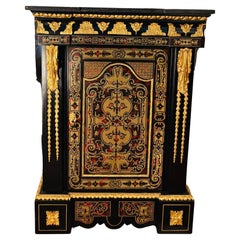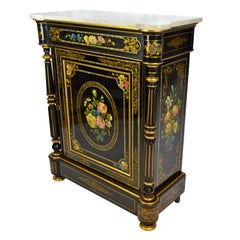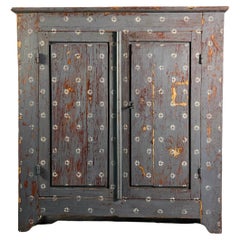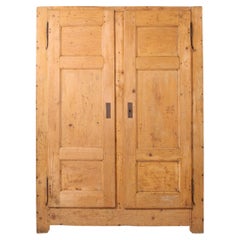Three Centuries Shop Cupboards
to
Height
to
Width
to
Depth
to
2
2
2
2
1
1
1
2
2
2
2
2
A 19 C French Louis XIV Style "Meuble D'Appui" after a Model by Mathieu Belfort
By André-Charles Boulle
Located in Vancouver, British Columbia
A french Louis XVI style grey marble topped Meuble d'Appui after a model by Mathieu Belfort.The ebonized cabinet is inlaid with brass and has all-over lavish gilded bronze mounts a...
Category
Antique Late 19th Century French Napoleon III Cupboards
Materials
Brass, Ormolu
Napoleon III Ebonized and Painted Commode Called Meuble D’appui in French
Located in Vancouver, British Columbia
A Napoleon III ebonized cabinet with front and sides decorated with hand painted floral medallions. The cabinet has turned columns to eac...
Category
Antique Late 19th Century French Napoleon III Cupboards
Materials
Mahogany
Related Items
19th Century Painted French Dresser
Located in Cirencester, GB
We have added the off white painted pattern detail to this lovely authentic antique 19th century French cupboard. A very versatile piece i...
Category
Antique 19th Century French Rustic Cupboards
Materials
Pine
19th Century French Scrubbed Pine Cupboard
Located in London, GB
A beautifully patinated 19th century scrubbed pine cupboard from the alpine Haute-Savoie region. Pegged and nailed in construction, with decorative forged iron hinges and original lo...
Category
Antique 19th Century French Country Cupboards
Materials
Iron
Napoleon III Inlaid Rosewood Cupboard
Located in Montelabbate, PU
Napoleon III container cabinet veneered in cherry wood, inlaid in bois de rose, golden bronze fragments. Grey veined marble top.
Packaging with bubble wrap and cardboard boxes is included. If the wooden packaging is needed (fumigated crates or boxes) for US and International Shipping...
Category
Antique Early 1900s French Cupboards
Materials
Marble, Bronze
French Painted Linen Cupboard
Located in Leamington Spa, Warwickshire
Useful 19th century French painted pine two door linen cupboard. 1840.
Code: 8885
Dimensions:
W: 48" (121.9 cm)
H: 85" (215.9 cm)
D: 20" (50.8 cm)
Category
Antique 19th Century French Cupboards
Materials
Pine
Early 19th Century French Oak Bassette, Small Armoire, Buffet D'appui
Located in Fayetteville, AR
From the town of Bazoches in the Le Perche region of Normandy, France, this hand carved oak bassette or petite armoire from the early 19th century is detailed with inlaid exotic woods depicting vines, leaves and stars. Its two paneled doors on iron fiche hinges feature ornate iron escutcheons. The doors open to reveal two interior shelves. Standing on sturdy cabriole legs, this piece displays hand pegged construction both at the joinery...
Category
Antique Early 19th Century French Wardrobes and Armoires
Materials
Fruitwood, Oak
$3,495
H 53 in W 51 in D 23.25 in
19th Century French Painted Cupboard
Located in Gloucestershire, GB
Early 19th Century French high-waisted cupboard.
This beautiful piece offers generous storage and unusual form. The top section with glazed doors featuring decorative carved swags an...
Category
Antique Early 19th Century French Country Cupboards
Materials
Wood
19thc Large French Pine Panelled Cupboard
Located in Staffordshire, GB
Circa 1880.
19thc Large French Pine Panelled Cupboard
Kitchen, Bedroom, Hall or Boot room
Sourced from the South of France
Measures: W162 x D40 x H233cm.
Category
Antique Late 19th Century French Cupboards
Materials
Pine
19th Century French Two-Piece Gothic Style Oak Cabinet
Located in Milford, NH
A fine form two-piece oak Gothic style cabinet in old dark finish with trefoil lined crest surmounting an upper tracery gallery back, over a singl...
Category
Antique Early 19th Century French Gothic Revival Cabinets
Materials
Oak
Louis XVI Style Gilt Metal Mahogany Meuble d'Appui
Located in Astoria, NY
Louis XVI Style Gilt Metal Mounted Mahogany and White Marble Top Meuble d'Appui, late 19th century, fitted with a central cupboard enclosing two shelves. 44" H x 50" W x 19" D. Keywo...
Category
Antique Late 19th Century European Louis XVI Credenzas
Materials
Metal
Antique French Table Top Cabinet Louis XV Style Carved Oak w Key c. 1920s
Located in Tyler, TX
RARE Antique French Country Louis XV Style Oak Table Top Cabinet with Carved Door, Crown and Key~~ c.1920s
This is a unique example of antique classic French Country decor~~hard to ...
Category
Early 20th Century French Louis XV Cabinets
Materials
Oak
$1,475
H 25.5 in W 19.5 in D 12 in
Rare and Palatial Late 19th Century Gilt Bronze-Mounted Marquetry Cabinet
By André-Charles Boulle
Located in Long Island City, NY
A Rare and Palatial Late 19th Century Gilt Bronze Mounted Louis XVI Style Marquetry and Parquetry Cabinet
A heavy marble top above a bronze frieze with three paneled doors decorated with inlaid floral marquetry designs. The center door with gilt bronze bearded men faces, the bottom is centered by a mask of a beautiful woman with two lion paws on her sides and a pair of floral cornucopia above her. The sides of the cabinet are quartered veneered, standing on six spiral bronze...
Category
Antique Late 19th Century French Belle Époque Cabinets
Materials
Marble, Bronze, Ormolu
$75,000
H 53 in W 63 in D 22 in
Mid-19th Century French Charles X Period Bird's Eye Maple Tall Buffet D'Appui
Located in Fayetteville, AR
This mid-nineteenth century French Charles X period buffet d'appui, or tall buffet, is constructed of bird's eye maple and has a beveled black marble top. An inlaid walnut scrolling ...
Category
Antique Mid-19th Century French Charles X Buffets
Materials
Marble
$4,995
H 47.5 in W 50.5 in D 18 in



